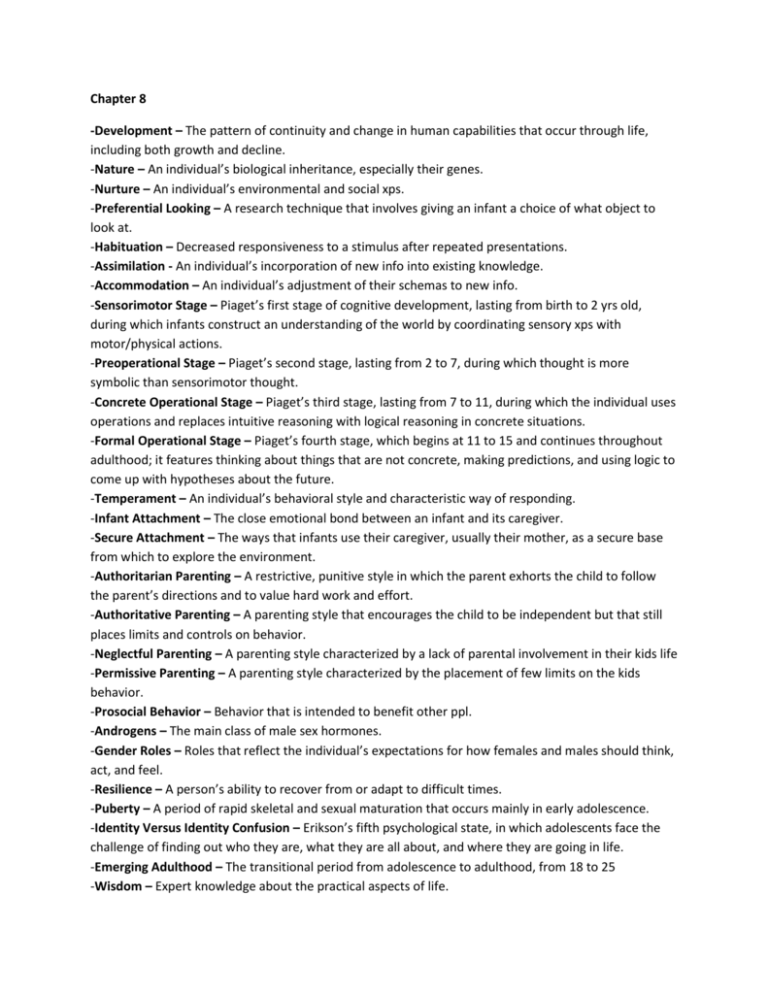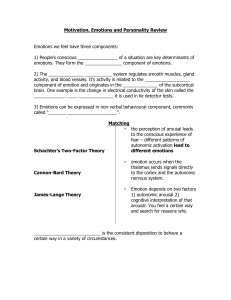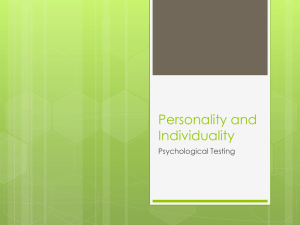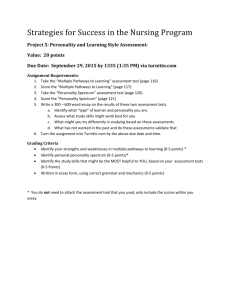
Chapter 8
-Development – The pattern of continuity and change in human capabilities that occur through life,
including both growth and decline.
-Nature – An individual’s biological inheritance, especially their genes.
-Nurture – An individual’s environmental and social xps.
-Preferential Looking – A research technique that involves giving an infant a choice of what object to
look at.
-Habituation – Decreased responsiveness to a stimulus after repeated presentations.
-Assimilation - An individual’s incorporation of new info into existing knowledge.
-Accommodation – An individual’s adjustment of their schemas to new info.
-Sensorimotor Stage – Piaget’s first stage of cognitive development, lasting from birth to 2 yrs old,
during which infants construct an understanding of the world by coordinating sensory xps with
motor/physical actions.
-Preoperational Stage – Piaget’s second stage, lasting from 2 to 7, during which thought is more
symbolic than sensorimotor thought.
-Concrete Operational Stage – Piaget’s third stage, lasting from 7 to 11, during which the individual uses
operations and replaces intuitive reasoning with logical reasoning in concrete situations.
-Formal Operational Stage – Piaget’s fourth stage, which begins at 11 to 15 and continues throughout
adulthood; it features thinking about things that are not concrete, making predictions, and using logic to
come up with hypotheses about the future.
-Temperament – An individual’s behavioral style and characteristic way of responding.
-Infant Attachment – The close emotional bond between an infant and its caregiver.
-Secure Attachment – The ways that infants use their caregiver, usually their mother, as a secure base
from which to explore the environment.
-Authoritarian Parenting – A restrictive, punitive style in which the parent exhorts the child to follow
the parent’s directions and to value hard work and effort.
-Authoritative Parenting – A parenting style that encourages the child to be independent but that still
places limits and controls on behavior.
-Neglectful Parenting – A parenting style characterized by a lack of parental involvement in their kids life
-Permissive Parenting – A parenting style characterized by the placement of few limits on the kids
behavior.
-Prosocial Behavior – Behavior that is intended to benefit other ppl.
-Androgens – The main class of male sex hormones.
-Gender Roles – Roles that reflect the individual’s expectations for how females and males should think,
act, and feel.
-Resilience – A person’s ability to recover from or adapt to difficult times.
-Puberty – A period of rapid skeletal and sexual maturation that occurs mainly in early adolescence.
-Identity Versus Identity Confusion – Erikson’s fifth psychological state, in which adolescents face the
challenge of finding out who they are, what they are all about, and where they are going in life.
-Emerging Adulthood – The transitional period from adolescence to adulthood, from 18 to 25
-Wisdom – Expert knowledge about the practical aspects of life.
Chapter 9
-Motivation – The force that moves ppl to behave, think, and feel the way they do.
-Instinct – An innate (unlearned) biological pattern of behavior that is assumed to be universal
throughout a species.
-Need – A deprivation that energizes the drive to eliminate or reduce the deprivation.
-Drive – An aroused state that occurs bcus of a physiological need.
-Homeostasis – The body’s tendency to maintain an equilibrium, or ready state.
-Yerkes-Dodson Law – The psychological principle stating that performance is best under conditons od
moderate arousal rather than either low or high arousal.
-Set Point – The weight maintained when the individual makes no effort to gain or lose weight.
-Estrogens – The class of sex hormones that predominate in females, produced mainly by ovaries.
-Androgens – Sex hormone in males produced by the testes and made by adrenal glands in both sexes.
-Human Sexual Response Pattern – The characteristic sequence of physiological changes that humans
xp during sexual activity, 4 stages; excitement, plateau, orgasm, and resolution.
-Sexual Orientation – The direction of an individual’s erotic interests today viewed as a continuum from
exclusive male-female relations to exclusive same sex relations.
-Hierarchy of Needs – Maslow’s theory that human needs must be satisfied in the following sequence:
physiological needs, safety, love and belongingness, esteem, and self-actualization.
-Self-Actualization – The motivation to develop one’s full potential as a human being - the highest and
most elusive of Maslow’s proposed needs.
-Self-Determination Theory – Deci and Ryan’s theory asserting that all humans have three basic, innate
organismic needs: competence, relatedness, and autonomy.
-Intrinsic Motivation – Motivation based on internal factors such as organismic needs as well as
curiosity, challenge, and fun.
-Extrinsic Motivation – Motivation that involves external incentives such as rewards and punishments.
-Self-Regulation – The process by which an organism effort fully controls behavior in order to pursue
important objectives.
-Emotion – Feeling, or affect, that can involve physiological arousal (fast heartbeat), conscious xp
(thinking about being in love w/ someone), and behavioral expression (a smile or grimace).
-Polygraph – A machine, AKA lie detector, monitors changes in the body, used to try to determine
whether someone is lying.
-James-Lange Theory – The theory that emotion results from physiological states triggered by stimuli in
the environment.
-Cannon-Bard Theory – The proposition that emotion and physiological reactions occur simultaneously.
-Two-factor Theory of Emotion – Schachter and Singer’s theory that emotion is determines by two
factors: physiological arousal and cognitive labeling.
-Facial Feedback Hypothesis – The idea that facial expressions can influence emotions as well as reflect
them.
-Display Rules – Sociocultural standards that determine when, where, and how emotions should be
expressed.
-Positive Affect – Positive emotions such as joy, happiness, and interest.
-Negative Affect – Negative emotions such as anger, guilt or sadness.
-Broaden-and-build Model – Frederickson’s model of positive emotion, stating that the function of
positive emotions lies in their effects and ability to build resources.
Chapter 10
-Personality - A pattern of enduring, distinctive thoughts, emotions, and behaviors that characterize the
way an individual adapts to the world.
-Psychodynamic Perspectives – Theoretical views emphasizing that personality is primarily unconscious.
-Ego – The Freudian structure of personality that deals with the demand of reality.
-Superego – The Freudian structure that serves as the harsh internal judge of behavior, conscious.
-Id – The part of the person that Freud called the “it” consisting of unconscious drives, the person’s
reservoir of sexual energy.
-Defense Mechanisms – Tactics the ego uses to reduce anxiety by unconsciously distorting reality.
-Oedipus Complex – According to Freud, a boy’s intense desire to replace his dad and enjoy the
affections of his mom.
-Archetypes – Emotionally laden ideas and images that have rich and symbolic meaning for all people.
-Collective Unconscious – Carl Jung’s name for the impersonal, deepest layer of the unconscious mind,
shared by all humans’ bcus of their common ancestral past.
-Individual Psychology – Alfred Adler’s view that ppl are motivated by purposes and goals and that
perfection, not pleasure, is the key motivator in life.
-Humanistic Perspectives – Theoretical views stressing the person’s capacity for personal growth and
positive human qualities.
-Unconditional Positive Regard – Carl Roger’s construct referring the individual’s need to be accepted,
valued, and treated positively regardless of their behavior.
-Conditions of Worth – The standards that the individual must live up to in order to receive positive
regard from others.
-Trait Theories – Theoretical views stressing that personality consists of broad, enduring dispositions
(traits) that tend to lead to characteristic responses.
-Big Five Factors of Personality – The five super-traits that are thought to describe the main dimensions
of personality: neuroticism (emotional instability), extraversion, openness to experience, agreeableness,
and conscientiousness.
-Subjective Well-Being – A person’s assessment of their own level of positive affect relative to negative
affect, and an evaluation of their life in general.
-Personological and Life Story Perspectives – Theoretical views stressing that the way to understand the
person is to focus on their life history and life story.
-Social Cognitive Perspectives – Theoretical views emphasizing conscious awareness, beliefs,
expectations, and goals.
-Self-Efficacy – The belief that on can master a situation and produce positive change.
-Cognitive Affective Processing Systems (CAPS) – Walter Mischel’s theoretical model for describing that
our thoughts and emotions about ourselves and the world affect our behavior and become linked in
ways that matter to behavior.
-Behavioral Genetics – The study of the inherited underpinnings of behavioral characteristics.
-Self-Report Test – Also called an objective test or an inventory, a method of measuring personality
characteristics that directly asks ppl whether specific items describe their personality traits.
-Empirically Keyed Test – A type of self-report test that presents many questionnaire items to two
groups that are known to different in some central way.
-Minnesota Multiphasic Personality Inventory (MMPI) – The most widely used and researched
empirically keyed self-report personality test.
-Face Validity – The quality of seeming, on the surface, to fit a particular trait in question.
-Projective Test – A personality assessment test that presents individuals with an ambiguous stimulus
and asks them to describe it or tell a story about it – to project their own meaning onto the stimulus.
-Rorschach Inkblot Test – A famous projective test that uses an individual’s perception of inkblots to
determine their personality.
-Thematic Apperception Test (TAT) –A projective test that is designed to elicit stories that reveal
something about an individual’s personality. Measure of motives.











